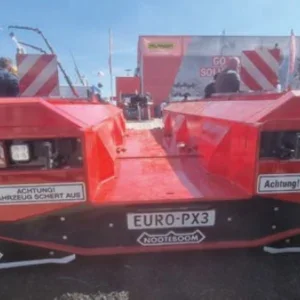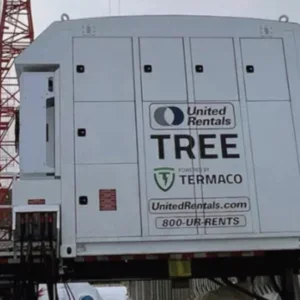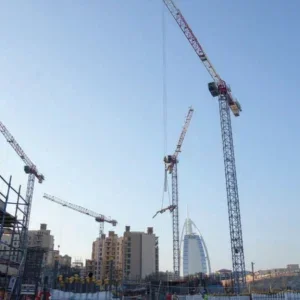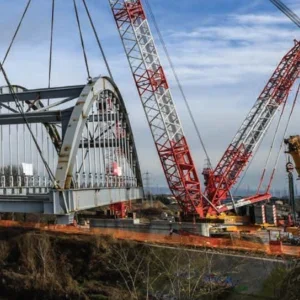The French will probably remember 1998 as a golden year. The World Cup was won on home soil and the economy boomed.
True, the financial collapse of Russia knocked 30% off the stock market in August, wiping out all the benefits of the earlier boom, but business confidence remained sound and inflation was at an all time low of just below an annualised 1%.
The crane industry, too, continued its revival as rental companies and contractors sought to expand their fleets or renew old stock dating back to before the recession of the early 1990s. “There is confidence back in the market,” says Grove France’s president-directeur general Gilles Marchand.
In 1995 just over 100 mobile cranes were sold in France; in 1996 the figure was just over 150; and in 1997 205 mobile cranes were sold – a figure representing 16% of the European market. Estimates for 1998 put sales at about 240 units. Clearly this growth will not continue at such a rate. Predictions for 1999 are that sales will remain steady rather than continue their dramatic rise. Though sales are up, they are still a long way from what the French market used to be, when, not so many years ago, several hundred units were sold each year. Moreover, the rental companies report that their rates remain suppressed.
Evidence of the relative health of the French market is provided by the production figures posted liberally around PPM’s factory at Montceau-les-Mines. Between January and August 1997 201 machines (mobile cranes and Superstacker reach stackers) were rolled out of the gate. For January to August 1998 the figure was 276.
Many of these machines are for export, but according to Fil Filipov, the president of PPM’s parent company Terex Lifting, PPM cranes accounted for about 47 or 48 of the 100-or-so ATs that were sold in France in the first six months of 1998. Filipov claims that PPM has about a half share of the markets in which it competes – namely the 25t/35t range, 55t and 120t.
The highest volume seller is the two-axle 25t/35t Quadral range. Up to 20 a month are turned out, or one each working day. The 55t-capacity, three-axled ATT 600s roll out at a rate of about eight a month.
For the cranes, only the booms are manufactured by PPM. All other sections and components are supplied by subcontractors for final assembly. For the stackers, not even the booms are manufactured on site. As stacker booms do not need to be as light as crane booms, they are not so technologically intensive so are manufactured by subcontractors too. Stacker booms, like the crane and stacker chassis, come from Portugal, mainly, and Poland.
Here at PPM, welders work in two shifts to make the booms and they also supply other Terex plants in Italy (Bendini) and Conway, USA.
A recent change at Montceau-les-Mines has been the doubling of the size of the parts stock. Until 1996, parts were kept some distance away in Lyon. The parts inventory has been increased from FF14m in value to FF30m, with 16,000 different references, 6,000 of which are used regularly.
As reported in the last issue of Cranes Today, new from PPM is the four-axle, 90t-capacity ATT 900 featuring a 53m boom, the longest boom in its class. The crane was displayed to dealers, customers and potential customers at an open house at the plant in October.
Terex PPM is taking a cautious approach to the launch of the ATT 900. When the 600 was launched, in the days before the May 1995 Terex takeover, about 30 had to be recalled from the field because of teething problems. With the ATT 900 five are being given to customers in France and Germany to iron out any bugs that may manifest themselves before the full marketing splash begins. “We want to avoid the problems of the past and get any problems sorted out first,” says Terex Lifting vice president Steve Filipov, Fil’s son.
When full production begins, 20 units are planned for 1999 and Filipov Junior expects all to be pre-sold.
Moving with the times, PPM also unveiled a new look for its cranes at the open house. The ATT 900 has a rounded styling and a tilting cab. A prototype two axle Quadral Evolution model was also shown with the new-look rounded cab.
On the back of the open day, PPM sold three units of its biggest AT, the 120t-capacity ATT 1354, to the German rental company IKH.
The PPM facility at Montceau-les-Mines also makes the Superstacker reach stacker. Terex sells about 25 of these a year into the USA but through a reorganisation in the wake of the acquisition of American Crane, this will stepped up to about 55, Filipov says. The basic bodies of the Superstackers, without boom, cylinders or spreaders, will be shipped from France to Wilmington, North Carolina, where American Crane is located.
Being patriotic people, the French are keen buyers of French products. But those not buying PPM cranes are likely to look to the German manufacturers.
Mannesmann Dematic reports that the French market is proving to be very stable now and that with all-terrain cranes making up 80% of all sales, it has grown market share continuously in the last few years.
In addition to its traditional strength in large cranes, Mannesmann Dematic has also developed a segment of the market thought to be almost dead with its 25t AC 25 City Class crane. The new three-axle AC 40-1 has also had a good response from the French market, Mannesmann Dematic says. “The compactness of this machine with a clearance height of just 3m is of great interest for many French users,” says marketing director Roland Schug.
Tadano Faun says that its analysis of crane sales shows that there is a tendency to three axle cranes in the 50t-60t class, though 30t-40t and 80t categories are also growing. Tadano Faun reckons to have had a good 1998 in France, with its Tadano rough terrain and Faun all-terrain models. By the end of October sales had hit 36 units, which was 40% up on the number of sales made throughout the whole of 1997. Though the RT market is small, 30t Tadanos are popular, with 11 units sold. The company adds that it, too, has high hopes for strong deliveries in 1999.
Marchand of Grove France says Grove’s two- and three-axle, 30t to 80t range models have been successful, selling to Montagrues, FAL Industrie, Lambert Levage, Carrier and SMMI.
“The market in France for bigger five- and six-axle cranes is limited, though the GMK 5160 and the high technology of the Wilhelmshaven-built GMK cranes in general are well accepted in France, giving us a strong position in the important AT market,” he says.
Liebherr, too, reports strong demand in the 35t, 50t and 90t categories. By 1 November it had delivered 70 mobile cranes to France, compared with 53 for the whole of 1997. The 90t-capacity LTM 1090/2 has sold well, with 50 units going to France since its launch in 1996. Liebherr believes that 1999 will be a good year too, having already taken orders for 160t and 300t cranes.
One of Liebherr’s biggest clients is Mediaco, one of France’s top five rental companies and lifting contractors which together make up about 50% of the market. Mediaco has more than 300 telescopic cranes from 20t to 800t capacities, as well as 250 trucks, cherry pickers and access platforms. In 1998 it bought a 350t, seven-axled Liebherr LTM 1350, the first crane of this type in France, Liebherr says. This crane will cover the south of France and be based in Marseilles, where Mediaco has its headquarters.
Mediaco also bought eight units of Liebherr’s six-axle LTM 1300-1, for delivery in 1999, plus 10 units of the 90t LTM 1090-2 and three LTM 1050-2s.
Mediaco also bought 10 units of the 70t ATF 70-4 from Tadano Faun, plus three of the 50t ATF 50-3 and four rough terrain TR 300EXs. From PPM it bought six 35t ATT 400s.
Mediaco president Christian-Jacques Vernazza says that his purchases represent “the best ratio quality/price cranes in the world in their own range”.
With the establishment of a new agency in Avignon in 1998, Mediaco has 28 locations and plans to open two more in 1999 in Clermont-Ferrand and Bordeaux. Other initiatives include the launch of two companies to service the petroleum industry: an industrial cleaning company called T2N and a logistics operation called Mediaco International Worldwide.
Sister company Fostrans bought four new lattice boom crawlers: a Demag CC 2800 to be delivered in March, a Liebherr LR 1400-1, and two LR 1260s. It also bought a Manitowoc 888 for renting or sale in the USA. Fostrans has live projects in Madeira, Lebanon, Egypt and Sweden, as well as France.
In spite of this major investment programme, Vernazza says that the French market has been “quite difficult this year, with low prices”. He adds: “The industrial activity in France is not as strong as in other European counties such as Holland and Germany.” Says Vernazza: “There are too many big cranes above 160t on the market and not enough jobs to feed them all.”






